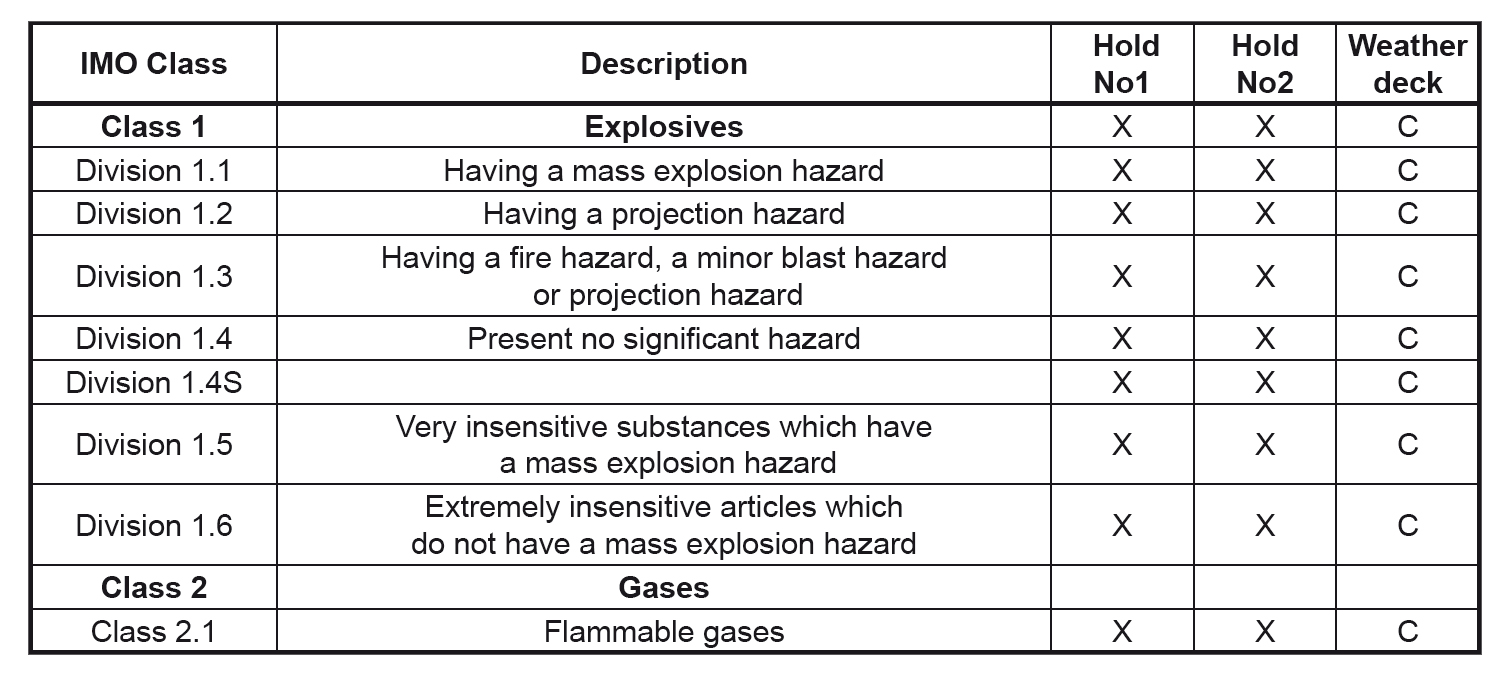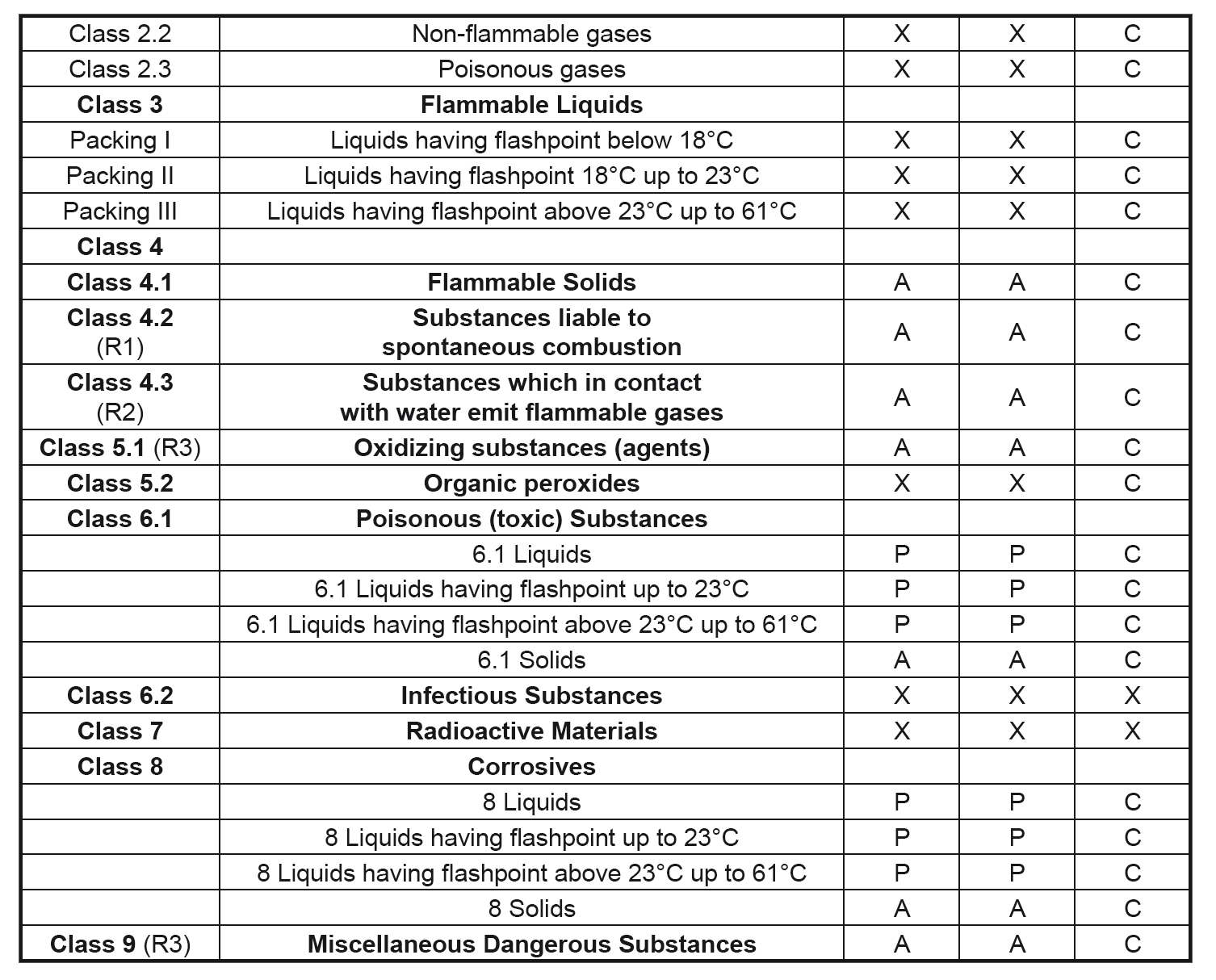

Dangerous goods classes
Classes of dangerous goods according to SOLAS (Chapter VII, Part A), the BC-Code and the IMDG-Code, are as follows:
CLASS 1 – Explosives
Division 1.1 Substances and articles which have a mass explosion hazard.
Division 1.2 Substances and articles which have a projection hazard but not a mass explosion hazard.
Division 1.3 Substances and articles which have a fire hazard and either a minor blast hazard or a minor projection hazard or both, but not a mass explosion hazard.
Division 1.4 Substances and articles which present no significant hazard.
Subdivision 1.4S contains substances and articles so packaged, or designed, that any hazardous effects arising from accidental functioning are confined within the package unless the package has been degraded by fire, in which case all blast or projection effects are limited to the extent that they do not significantly hinder fire-fighting or other emergency response efforts in the immediate vicinity of the package.
Division 1.5 Very insensitive substances which have a mass explosion hazard.
Division 1.6 Extremely insensitive articles which do not have a mass explosion hazard.
CLASS 2 – Gases, compressed, liquefied or dissolved under pressure
Class 2.1 Flammable gases
Class 2 .2 Non-flammable, non-toxic gases
Class 2 .3 Toxic (poisonous) gases
CLASS 3 – Flammable liquids
Flammable liquids are grouped for packing purposes according to their flashpoint, their boiling point, and their viscosity.
CLASS 4 – Flammable solids; substances liable to spontaneous combustion; substances which, in contact with water, emit flammable gases
Class 4.1 Solids having the properties of being easily ignited by external sources, such as spark and flames, and of being readily combustible, or of being liable to cause or contribute to a fire or cause one through friction.
Class 4. 2 Solids or liquids possessing the common property of being liable spontaneously to heat and to ignite.
Class 4.3 Substances which, in contact with water, emit flammable gases.
CLASS 5 – Oxidising substances (agents) and organic peroxides
Class 5.1 Substances which, although themselves are not necessarily combustible,
but may, either by yielding oxygen or by similar processes, increase the risk
and intensity of fire in other materials which they come into contact with.
Class 5.2 Organic peroxides
CLASS 6 – Toxic and infectious substances
Class 6.1 Toxic substances liable either to cause death or serious injury or to harm health if swallowed or inhaled, or by skin contact.
Class 6.2 Infectious substances.
CLASS 7 – Radioactive materials
CLASS 8 – Corrosive substances
Substances, which, by chemical action, will cause severe damage, when in contact with living tissue or, in case of leakage, will materially damage, or even destroy, other goods or the means of transport. Many substances are sufficiently volatile to emit vapour irritating to the nose and eyes.
CLASS 9 – Miscellaneous dangerous substances and articles
Further reading: International Maritime Dangerous Goods Code.
Example of dangerous goods intended to be carried onboard the MPV BALTICA
P – Packaged goods permitted
C – Packaged goods in closed freight containers only permitted
A – Packaged and solid bulk goods permitted
B – solid bulk goods permitted
X – NOT PERMITTED
Remarks:
1. Class 4.2 shall include Seed Cake, b) and c), UN 1386 and 2217.
2. Class 4.3 without Aluminium Ferrosilicon, UN 1395, Aluminium Silicon, UN 1398, Ferrosilicon, UN 1408, Zinc Ashes, UN 1435.
3. Class 5.1 shall include Ammonium Nitrate and Ammonium Nitrate Fertilizers.
4. Class 9 shall include Ammonium Nitrate and Ammonium Nitrate Fertilizers.

